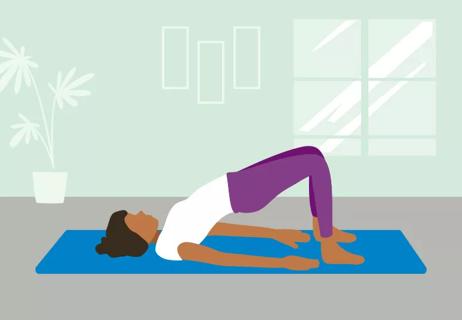Find relief by keeping a neutral spine, trying a medium-firm mattress and using pillows for support

The pain of sciatica can make it hard to sleep. Like, really hard to sleep. Fortunately, there are adjustments you can make and steps you can take to ease your pain and finally get a better night’s sleep.
Advertisement
Cleveland Clinic is a non-profit academic medical center. Advertising on our site helps support our mission. We do not endorse non-Cleveland Clinic products or services. Policy

There’s no perfect sleeping position for sciatica pain. But you may find that one of these options works best for you.
Sleeping and sciatica often don’t mix. It can be impossible to get a good night’s rest when your back or legs are throbbing or tingling! But physical therapist Cara Sieberth, PT, says there are steps you can take to find relief from sciatica and finally get some shut-eye.
Getting your spine into a neutral position may help alleviate some of your sciatica pain while you sleep.
When you lie down, ensure that your head, shoulders and hips are in a straight line. Put a small pillow under your neck and head, but not your shoulders. You may also need to put a pillow under your knees to keep your back from arching too much.
“Once you get in this position, think about what hurts or what feels good,” Sieberth suggests. “Then, you can tweak your sleeping position from there.”
Advertisement
If you’re sleeping on your side, try placing a pillow between your knees.
“This aligns your hips and takes pressure off the pelvis,” Sieberth explains. “Another option is to place a pillow behind your back for support, which also keeps you from rolling.”
Regular pillows work fine. But a body pillow is a great option, too, because they’re designed to mold to your body and stay in place while you sleep.
If spinal stenosis is at the root of your sciatica, it can be helpful to sleep in a slightly rounded position. This can help open the narrowed spaces in the spine.
To mimic this position while you sleep:
A warning, though: If spinal stenosis isn’t the cause of your sciatica, these positions may cause you more pain instead of bringing you relief. If it hurts, switch it up.
Sleeping on your stomach forces you to arch your back and turn your head to one side. For the most part, it’s not great for your back, and it’s typically best to avoid it when you’re dealing with sciatica pain.
But … not always. In some cases, stomach sleeping could be the one position that brings you the most relief.
“For a few people, arching their back actually provides relief from sciatica,” Sieberth notes. “In general, stick with the sleeping position that feels best for you.”
Sleeping on the wrong mattress can make sciatica pain worse, or at least keep it from getting better.
“Try to find a comfortable position on the mattress you already have,” Sieberth says. “Use your pillows or even a mattress topper to make some small changes. Then, once you figure out what gives you some relief, you can decide whether a firmer or softer mattress might work for you.”
So, what should you look for if you do decide you need a new one? A review of studies found that a medium-firm mattress is best for bringing relief from lower back pain.
Look for something that doesn’t create a lot of extra curve to your spine so you can maintain a normal, neutral spinal alignment.
Stretching your back and strengthening your abdominal muscles (aka your core) helps take pressure off your spine. To alleviate sciatica pain, try stretches like the piriformis stretch and cobra pose.
“Try both, and if one helps relieve your symptoms more than the others, focus on that,” Sieberth recommends. “Spend one to two minutes stretching three to five times a day, including right before bed.”
Advertisement
Tap into other pain relief options before bedtime to help relieve mild sciatic symptoms.
Your sciatica pain may feel more noticeable at night. But what you do during waking hours can affect how bad your pain gets at night. Here’s what Sieberth suggests:
Advertisement
To find the greatest relief from your sciatica — both at night and during the day — you need to figure out what’s behind it.
“The cause of your sciatica affects what positions or activities bother you,” Sieberth explains. “This also determines which sleeping positions work best for you. For instance, if you have a bulging disk, you may find back sleeping comfortable. If you have spinal stenosis, you might prefer side sleeping.”
Whatever’s causing your sciatica, don’t assume you have to live with it. If it interferes with your quality of sleep, talk with a healthcare provider about solutions. With the right medical treatment, you can get relief from sciatica pain — and head off to dreamland again.
Advertisement
Learn more about our editorial process.
Advertisement

Try these moves to relieve butt pain and numbness

This chronic condition most commonly causes pelvic pain and severe cramping during periods, but it can bring other types of pain symptoms, too

Tart cherry juice contains natural compounds that may support better sleep

Looking down at your smartphone or computer screen can stress muscles in your neck, shoulders and back

Leg-related symptoms indicate DVT, while chest symptoms point to a pulmonary embolism

Dysarthria affects how you speak, while aphasia impacts how you use and understand words

If you’re waking up drenched, it could be menopause, stress, medications and other causes

Eat foods that are high in protein and low in animal fat and simple sugar

The best parenting style balances enforcing rules and showing plenty of love

Tips include cutting back on sugar, focusing on exercise and managing stress

It can be harder to let go when you’ve invested time, energy and emotions — but it might be the healthier choice long term